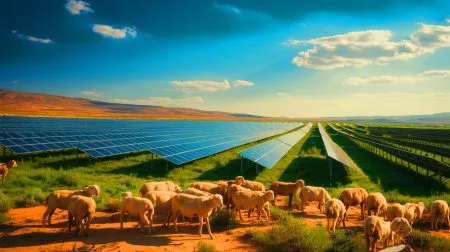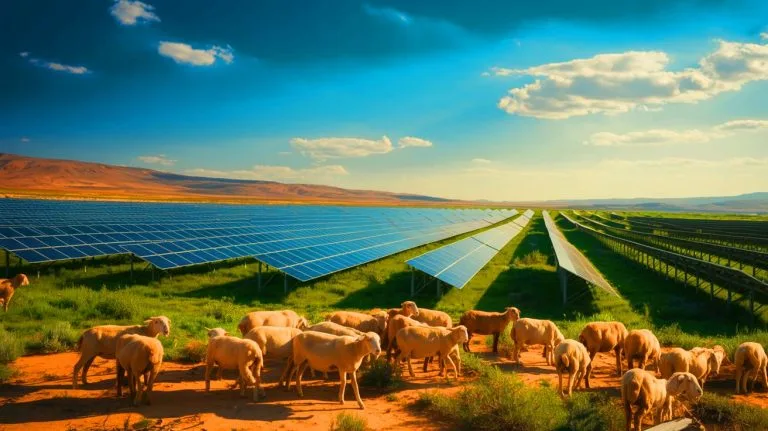| IN A NUTSHELL |
|
In the northwestern region of China, a groundbreaking solar power project is redefining both the landscape and local ecology. This massive solar farm, spread across hundreds of square miles, is not only a monumental feat of renewable energy technology but also a catalyst for ecological transformation. The neatly aligned photovoltaic panels are curbing erosion, promoting the growth of grasses, and attracting sheep herds that help maintain this nascent ecosystem. As one of the largest solar installations globally, it stands as a testament to China’s ambitious renewable energy goals and its potential for positive environmental impact.
The Unforeseen Ecological Benefits of Solar Farms
In Qinghai Province, a region traditionally characterized by its bleak, arid landscape, a pioneering energy project is rewriting the ecological narrative. Stretching over 235 square miles on the Tibetan Plateau, this solar farm holds the title of the world’s largest photovoltaic installation. Upon completion, it will feature over seven million solar modules, with the capacity to supply electricity to five million households. This immense scale not only underscores China’s commitment to renewable energy but also highlights the unforeseen ecological benefits that such projects can bring.
The solar panels serve as a physical barrier against the wind, effectively reducing soil erosion and slowing the encroachment of sand. By casting shade, they minimize moisture evaporation from the soil, creating a more hospitable environment for grass and shrub growth. This artificially induced microclimate has led to the emergence of vegetation in a region long known for its persistent droughts. The newfound greenery is attracting local wildlife, indicating a positive shift in the area’s ecological balance.
Economic Implications for Local Communities
The establishment of such a large-scale solar farm brings with it significant economic opportunities for local communities. Jobs in construction, maintenance, and operations have provided a much-needed boost to the local economy. The presence of grazing sheep, which help manage the vegetation, is a traditional practice that has been revitalized, offering additional income streams for herders.
The economic ripple effects extend beyond employment. As the farm generates vast amounts of clean energy, it contributes to the stabilization of energy prices and enhances energy security in the region. This, in turn, could lead to lower electricity costs for consumers and businesses, fostering economic growth. Moreover, the project positions Qinghai as a leader in renewable energy production, potentially attracting further investments and development.
Challenges and Environmental Concerns
Despite the positive impacts, the solar farm’s development is not without its challenges and environmental concerns. The sheer size of the installation requires careful planning to minimize its footprint on the local ecosystem. There is an ongoing need to balance the benefits of renewable energy with the potential disruption to wildlife and natural habitats.
Furthermore, the long-term sustainability of the project depends on effective management practices. Ensuring that the landscape remains conducive to both energy production and ecological health is crucial. This involves monitoring soil quality, vegetation growth, and wildlife populations to adapt management strategies as needed. The challenge lies in maintaining this balance over the lifespan of the solar farm, which could span several decades.
The Future of Renewable Energy in Arid Regions
This project in Qinghai sets a precedent for the future deployment of renewable energy technologies in arid regions worldwide. By demonstrating that solar installations can offer substantial environmental benefits, it challenges traditional perceptions of renewable energy’s role in ecological conservation. The success of this initiative could inspire similar projects in other parts of the world, particularly in areas struggling with desertification and drought.
The Qinghai solar farm also raises important questions about the scalability of such projects and their adaptability to different environments. While the benefits in this region are clear, the challenge will be to replicate these outcomes elsewhere, where environmental conditions and socio-economic contexts may vary. As global leaders in renewable energy look to expand their efforts, what lessons can be drawn from Qinghai’s experience to ensure sustainable and equitable energy transitions?
As the world continues to grapple with the dual challenges of climate change and energy demand, innovative projects like the Qinghai solar farm offer a glimpse of a possible future. However, as we consider replicating this model globally, how can we ensure that such initiatives are implemented in a way that balances energy needs with ecological preservation?
Did you like it? 4.7/5 (20)







Wow, 235 square miles of solar panels? That’s like a whole city covered in panels! 🌞
This is amazing! How do they keep the panels clean in such a dusty area? 🤔